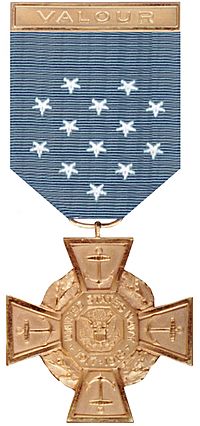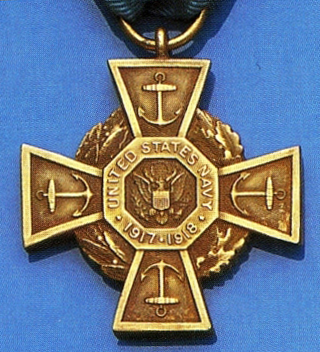Tiffany Cross Medal of Honor facts for kids
Quick facts for kids Tiffany Cross Medal of Honor |
|
|---|---|

1919–1942 Navy "Tiffany Cross" pattern
|
|
| Type | Medal (Decoration) |
| Eligibility | US Navy and Marine Corps personnel, 1917–1942 |
| Awarded for | Gallantry and intrepidity in actual conflict at the risk of one's life above and beyond the call of duty |
| Status | Obsolete 7 August 1942 |
| Description | Modified cross pattée |
| Motto | VALOUR |
| Statistics | |
| Established | 4 February 1919 (retroactive to 6 April 1917) |
| Precedence | |
| Equivalent | Medal of Honor |
| Next (lower) | Navy Distinguished Service Medal |
 Details of the Tiffany Cross |
|
The Tiffany Cross Medal of Honor was a special award given by the U.S. Navy and Marine Corps after World War I. It was a type of Medal of Honor, which is the highest military award for bravery.
The Navy wanted to honor two kinds of heroism: bravery in battle and bravery in a sailor's regular job. The original Medal of Honor looked like an upside-down star. For the new combat award, the Tiffany Company designed a new medal in the shape of a cross in 1919. This new cross-shaped medal was called the Tiffany Cross. It was meant for sailors or Marines who showed great courage and bravery during a fight with the enemy, risking their lives far beyond what was expected.
Contents
What the Tiffany Cross Medal Looks Like
The Tiffany Cross hangs from a light blue ribbon with 13 white stars. At the top of the ribbon, there is a bar with the word "VALOUR" on it.
The medal itself is a gold cross shape. It sits on top of a wreath made of oak and laurel leaves. Each arm of the cross has an old-fashioned anchor. In the middle of the cross, there is an eight-sided shape. It says "UNITED STATES NAVY" at the top and "1917·1918" at the bottom. The very center of this shape shows the Great Seal of the United States.
The back of the medal is flat. This was so that the names of the people who received the medal could be carved into it. Many medals had very detailed carvings.
How the Medal Was Approved
The Tiffany Cross Medal was officially approved by Congress on February 4, 1919. This was part of the same law that created other important Navy awards, like the Navy Cross and the Navy Distinguished Service Medal.
The law said that the President could give this Medal of Honor to any person in the Navy who showed amazing bravery and courage during a fight with the enemy. They had to risk their life far beyond what was expected, without harming their mission.
The Tiffany Company designed this medal. Even though it was approved in 1919, people could receive it for brave actions that happened as early as April 6, 1917. This was the date when the United States officially entered World War I.
Awards That Didn't Quite Fit
Even though the Tiffany Cross was supposed to be for bravery in "actual conflict," it was sometimes given for other reasons. For example, Floyd Bennett and Richard Byrd received it for exploring the Arctic. John Siegel got one for rescuing people at sea.
Because of these different types of awards, the way the Tiffany Cross program was managed was not very clear.
Why the Medal Became Unpopular
The Tiffany Cross was not very popular. One reason might have been that it looked a lot like the German Iron Cross. Many people who received it, like Richard E. Byrd, asked for and wore the older, star-shaped Medal of Honor instead.
Byrd received his Tiffany Cross on February 27, 1927. But then he received the classic star-shaped Medal of Honor on June 20, 1930. We don't know why he wanted to switch.
In 1942, the Navy decided to go back to using only the original 1862 star-shaped Medal of Honor. They also stopped giving out medals for actions that were not in combat.
When the Tiffany Cross was being given out, the next highest Navy award was the Navy Distinguished Service Medal. After that came the Navy Cross.
On August 7, 1942, the same day the Tiffany Cross was stopped, Congress changed the order of these awards. The Navy Cross became a higher award than the Distinguished Service Medal. The Navy Cross also became an award given only for bravery in combat.
People Who Received the Tiffany Cross
The U.S. Naval History & Heritage Command believes that 28 sailors and Marines received the Tiffany Cross. However, a close look at old photos, museum displays, and newspaper stories suggests that only 22 people actually received this specific version of the Medal of Honor.
These 22 people are thought to be the only ones who received the Tiffany Cross between 1919 and 1942. At least three of them (Byrd, Bennett, and Siegel) received the medal for actions that were not combat-related.
List of Recipients
Lavender background and † means the
Medal of Honor was given after the person died.
| Image | Name | Service | Date of action | Combat | Action |
|---|---|---|---|---|---|
 |
Osmond K. Ingram † | Navy | 15 October 1917 | Yes | Ingram died trying to release depth charges as a torpedo approached. His action was in combat. His Tiffany Cross medal is in a museum. |
 |
Alexander G. Lyle | Navy, Dental Corps | 23 April 1918 | Yes | Lyle risked his life under enemy fire to treat a wounded man. He was in combat. There is a photo of him wearing his Tiffany Cross. |
 |
Daniel A. J. Sullivan | Naval Reserve | 21 May 1918 | Yes | Sullivan bravely secured dangerous depth charges. His action was in combat. |
 |
Edouard V. M. Izac | Navy | 21 May 1918 | Yes | Izac gathered important information while a prisoner of war. He then escaped and brought the information to his allies. |
 |
Ernest A. Janson | Marine Corps | 6 June 1918 | Yes | Janson bravely attacked and scattered an enemy machine gun group by himself. He was in combat. There is a photo of him wearing his Tiffany Cross. |
 |
Weedon E. Osborne † | Navy, Dental Corps | 6 June 1918 | Yes | Osborne died while rescuing wounded men under heavy enemy fire. His medal is on display in a museum. |
 |
Orlando H. Petty | Naval Reserve, Medical Corps | 11 June 1918 | Yes | Petty cared for wounded soldiers despite artillery and gas attacks, even after his own gas mask broke. There is a photo of him wearing his Tiffany Cross. |
 |
Louis Cukela | Marine Corps | 18 July 1918 | Yes | Cukela bravely attacked and captured a German strongpoint by himself. There is a photo of him wearing his Tiffany Cross. |
 |
Matej Kocak † | Marine Corps | 18 July 1918 | Yes | Kocak silenced one machine gun nest alone and led a successful attack on another. He was in combat. |
 |
Joel T. Boone | Navy, Medical Corps | 19 July 1918 | Yes | Boone risked himself under intense fire to treat the wounded and bring in supplies. There is a photo of him wearing his Tiffany Cross. |
 |
Charles H. Hammann | Navy | 21 August 1918 | Yes | Hammann rescued another pilot who had been shot down. He was in combat. |
 |
David E. Hayden | Navy | 15 September 1918 | Yes | Hayden reached a wounded man, treated him, and carried him to safety despite heavy fire. His medal is in a museum. |
 |
John J. Kelly | Marine Corps | 3 October 1918 | Yes | Kelly attacked a machine gun nest alone during an artillery attack. There is a painting of him wearing his Tiffany Cross. |
 |
John H. Pruitt † | Marine Corps | 3 October 1918 | Yes | Pruitt captured two machine guns and forty prisoners by himself. His medal is in a museum. |
 |
James J. Madison | Naval Reserve | 4 October 1918 | Yes | Madison continued to lead his ship after being badly wounded during a U-boat attack. There is a photo of him wearing his Tiffany Cross. |
 |
John H. Balch | Naval Reserve | 5 October 1918 | Yes | Balch risked himself under intense fire to treat the wounded and set up a medical station. His medal is in a museum. |
 |
Robert G. Robinson | Marine Corps | 14 October 1918 | Yes | Robinson kept firing his weapon after being badly wounded in an air battle against twelve German planes. His medal is in a museum. |
 |
Ralph Talbot † | Marine Corps | 14 October 1918 | Yes | Talbot, with his gunner, shot down one plane in an air battle against twelve German aircraft. His medal is in a museum. |
|
|
John O. Siegel | Navy | 1 November 1918 | No | Siegel rescued two men from a burning ship before he was trapped by smoke. His medal is in a museum. |
 |
Floyd Bennett | Navy | 9 May 1926 | No | Bennett received his award for being part of what was believed to be the first successful flight to the North Pole and back. There is a photo of him receiving his medal. |
 |
Richard E. Byrd | Navy | 9 May 1926 | No | Byrd received his award for leading what was believed to be the first successful flight to the North Pole and back. There is a photo of him receiving his medal. |
 |
Frank Schilt | Marine Corps | 8 January 1928 | Yes | Schilt used a plane to evacuate wounded Marines while under enemy fire. There is a photo of him wearing his medal. |
See also

